|
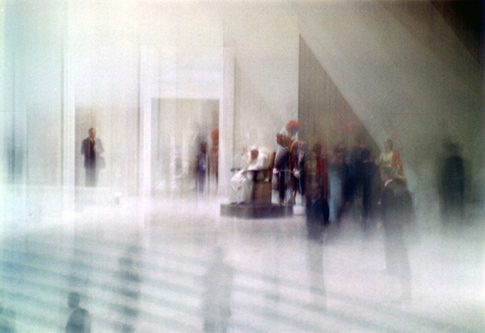
Für ein Leben nach dem Tod. Generalaudienz Audienzhalle 15. Dez. 2004, 2006
The video installation For a Life after Death follows the two artists, who were accredited as journalists to the Vatican for a year. In combination with some drawings from them, a portrait of the last months in the life of Pope John Paul II took shape in a form similar to a diary. The selected scenes, on one hand, document the staging of rituals in the Catholic faith, and on the other, the artists point to the church’s implicit economy and politics relating to the media, for which the Pope himself acts as the most important politician and media star in the Vatican. Between these scenes, there are, however, also sequences with flocks of birds in flight, which, in Christian iconography, have since time immemorial symbolized souls ascending into eternity.
Korpys/Löffler
Andree Korpys, * 1966 in Bremen (D), lives and works in Berlin (D)
Markus Löffler, * 1963 in Bremen (D), lives and works in Bremen (D)
 Korpys/Löffler, Für ein Leben nach dem Tod, 2006 Korpys/Löffler, Für ein Leben nach dem Tod, 2006
video (colour, sound)
72:30 min., loop
courtesy Meyer Riegger, Karlsruhe
VG Bild-Kunst, Bonn 2008
Korpys/Löffler, Für ein Leben nach dem Tod. Generalaudienz Petersdom 24. Nov. 2004, 2006
c-Print, 68 x 100 cm
courtesy Meyer Riegger, Karlsruhe
VG Bild-Kunst, Bonn 2008
Korpys/Löffler, Für ein Leben nach dem Tod. Generalaudienz Audienzhalle 15. Dez. 2004, 2006
c-Print, 68 x 100 cm
courtesy Meyer Riegger, Karlsruhe
VG Bild-Kunst, Bonn 2008
Korpys/Löffler, Für ein Leben nach dem Tod. Petrusskulptur Petersdom 12. Okt. 2004, 2006
c-Print, 68 x 100 cm
courtesy Meyer Riegger, Karlsruhe
VG Bild-Kunst, Bonn 2008
|
|
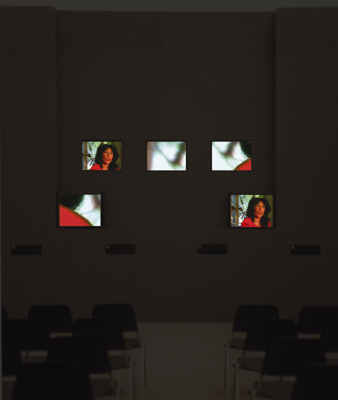
The Cave, 1993
The Cave denotes the cavern of Machpela near Hebron in West Jordan, in which Abraham, the common ancestor of Judaism and of Islam, is supposed to lie buried. According to mystical sources from Judaism, this is the entrance to the Garden of Eden; however, right up to today, Machpela has been the scene of political-religious tensions and conflicts. The American composer Steve Reich and the video artist Beryl Korot devoted a video-opera to the place and accordingly asked Israelis, Palestinians and Americans about the respective significance of Abraham in their faith. These recordings served as the basis for the music, libretto and scenography of the work. Alongside the original video-opera as performed with an orchestra, a second version arose as a video installation, which we can see here.
Beryl Korot * 1945, Steve Reich * 1936, live and work in New York (USA)
 Beryl Korot and Steve Reich, The Cave, 1993 Beryl Korot and Steve Reich, The Cave, 1993
5-channel video installation (colour, sound)
installation view Düsseldorf 1994
courtesy Beryl Korot (video) and Steve Reich (music)
photo: Beryl Korot
|
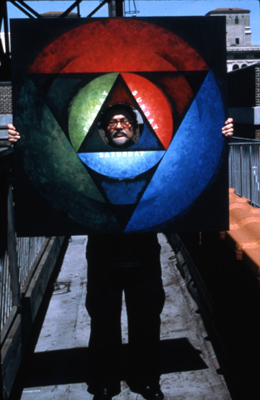
Self Portrait with Three-Day Weekend Mandala, 2005
The Project Three-Day Weekend (Sunday, Saturday, Friday) unites a social dream (a 30-hours work week) and ecumenical utopias (peaceful co-existence of all faiths, including atheism, within a secular state). Three-Day Weekend is my vision of symbolist images which can play a role of visual propaganda of these dreams and utopias. Everybody is welcome to join Three-Day Weekend society! All members, including artists, could send me proposals or suggestions on how to accomplish this lofty future of humanity.
Vitaly Komar
Vitaly Komar, * 1943 in the UdSSR, lives and works in New York (USA) Vitaly Komar, Self Portrait with Three-Day Weekend Mandala, 2005 Vitaly Komar, Self Portrait with Three-Day Weekend Mandala, 2005
courtesy Vitaly Komar and Ronald Feldman Fine Arts, New York
Vitaly Komar, Mandala # 1 (from the Three-Day Weekend project), 2005
tempera and oil on canvas
122 x 122 cm
courtesy Vitaly Komar and Ronald Feldman Fine Arts, New York
|
|
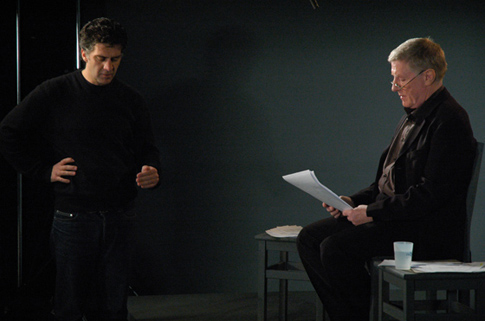
Hamburger Lektionen, 2006
In his film Hamburger Lektionen [Hamburg Lessons], the German film-maker Romuald Karmakar takes up the inflammatory preaching of the Imam Mohammed Fazazi in the Hamburg Al-Quds-Mosque in 2000. In it the Imam gives answers drawn from the Sharia to questions of everyday life and elucidates Islamic dogma whilst totally rejecting, for example, basic democratic rights. In the film, the actor Manfred Zapatka performs the transcribed texts. In the subtitles, background noises from the mosque are occasionally indicated, and they make the preceding socio-cultural surroundings evident and lift the anonymity of the studio setting. In this abstract presentation, the propaganda material becomes a document, which demonstrates the internal structure of inflammatory preaching and the radical rejection of rules drafted in any way differently.
Romuald Karmakar, * 1965 in Wiesbaden (D), lives and works in Berlin (D)
 Romuald Karmakar, Hamburger Lektionen, 2006 Romuald Karmakar, Hamburger Lektionen, 2006
digital projection (colour, sound)
133 min., loop
courtesy farbfilm verleih GmbH
|
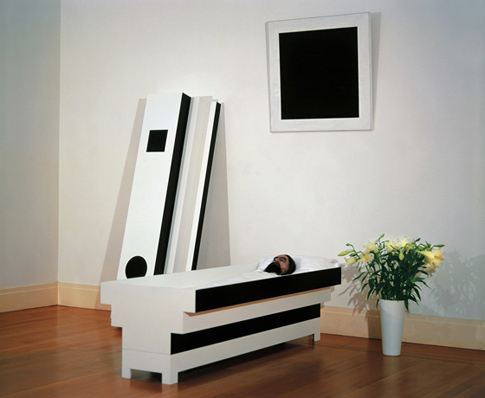
Corpse of Art, 2003–2004
The Slovenian artists' collective IRWIN has frequently reflected the symbolism and the aesthetics of East and West European avant-gardes. Their installation, Corpse of Art, copies the circumstances of the laying out of Malevich's corpse in his Leningrad flat in May 1935: displaying it in the Suprematist coffin designed by his student, Nikolai Suetin, according to Malevich's own concept. IRWIN shows the Black Square alone above the coffin – and leaves out the two realistic images from Malevich's work, which flanked the Suprematist icon in the original arrangement. In this way, IRWIN simultaneously radicalises and undermines Malevich's totalitarian claim to mould not only his whole life but also his own death. As a symbol of the failure of his utopias of Suprematism, IRWIN erects a memorial to them at the same time and makes Malevich's displayed corpse into the medium of his universal ideas beyond his own death.
IRWIN, founded in 1983
Dušan Mandic * 1954, Miran Mohar * 1958, Andrej Savski * 1961,
Roman Uranjek * 1961, Borut Vogelnik * 1959
 IRWIN, Corpse of Art, 2003–2004 IRWIN, Corpse of Art, 2003–2004
mixed media installation (wood, textile, wax, hair, vase, flowers)
dimensions variable
Courtesy Galerija Gregor Podnar, Berlin/Ljubljana
photo: Jesko Hirschfeld, 2007
|
|
|
|
|
<< Start < Prev 1 2 3 4 5 6 7 8 Next > End >>
|
|
Page 5 of 8 |



